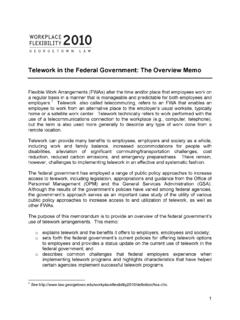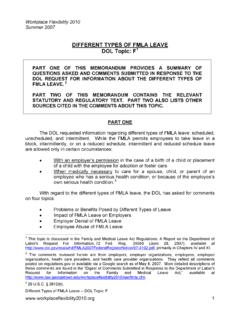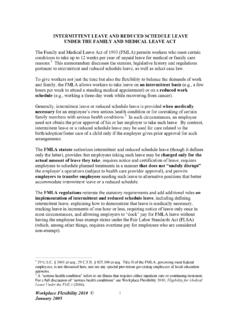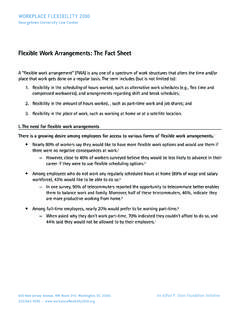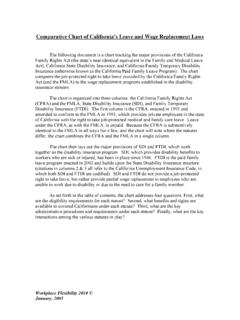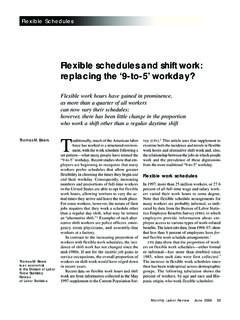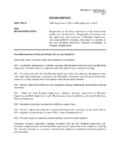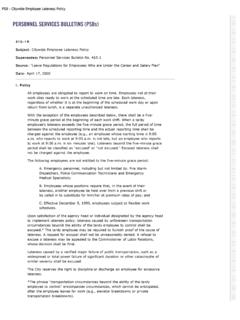Transcription of Flexible Work Arrangements: A Definition And Examples
1 WORKPLACE FLEXIBILITY 2010 Georgetown University Law Center600 New Jersey Avenue, NW, Room 340, Washington, DC 20001 An Alfred P. Sloan Foundation Initiative202/662-9595 work Arrangements: A Definition And ExamplesWorkplace Flexibility 2010 defines a Flexible work arrangement (FWA) as any one of a spectrum of work structures that alters the time and/or place that work gets done on a regular basis. A Flexible work arrangement includes:1. flexibility in the scheduling of hours worked, such as alternative work schedules ( , flex time and compressed workweeks), and arrangements regarding shift and break schedules;2. flexibility in the amount of hours worked, such as part time work and job shares; and3.
2 Flexibility in the place of work , such as working at home or at a satellite research indicates that workplaces today offer a wide range of Flexible work arrangements. What arrangements are provided, and how they are defined, can vary purposes of discussing policy approaches for advancing FWAs, therefore, we have attempted to impose some coherence on the range of such arrangements by categorizing them along the lines of our definition above , flexibility in work scheduling; flexibility in number of hours worked; and flexibility in place. The goal of this document is thus primarily to give you a sense of what the it is when we talk about FWAs. To achieve that goal, we have provided definitions and Examples of the most commonly provided FWAs within each category.
3 This document should be used as a glossary reference for our other FWA overview believe the level of specificity we have provided you in this document is sufficient to discuss policy approaches for increasing and enhancing FWAs in the workplace. Obviously, to implement any particular FWA in a workplace, a much greater level of specificity about the FWA would be required. When reading this document, please remember that the effective implementation of any FWA will necessarily be very work -place-specific, and will offer different levels of control and flexibility to both the employer and the Flexibility in work Scheduling1. Alternative work Schedules: Any schedule other than that which is standard to the work ) Flextime: Schedules based on worker needs within set parameters approved by a : A worker must work 40 hours per week and be present on a daily basis during core hours ( , from 10:00 am to 3:00 pm), and may, for example, adjust arrival and departure times as he/she wishes on a daily basis, or define new standard work hours ( , a set schedule of 7:00 am to 3:00 pm every day or of 7:00 am to 3:00 pm on Tues/Thurs and 10:00 am to 6:00 pm on Mon/Wed/Fri).
4 A worker must work 40 hours per week (but core hours do not apply), and may, for example, vary start and end times on a weekly, or even daily, schedule ; set a standard schedule as 7:00 am to 3:00 pm on Tues/Thurs (in order to meet the school bus, take a college class, etc.), and 9:00 am to 5:00 pm on Monday/Wednesday/Friday (this form of flextime may be modified to allow the worker to vary a standard schedule as needed , at exam time, early school dismissal days); occasionally work extra hours one day to make up for shorter hours worked another day; or aside from a weekly staff meeting on Friday mornings, work at night to better serve clients in a European time flextime arrangements may be modified to include situations where the worker is working, but is not present at the worksite ( , is teleworking) for all or some portion of the workweek.
5 B) Compressed Workweeks: Workers work full time hours in less than the traditional 5-day workweek by increasing daily hours worked. Examples : A worker works 10-hour days, 4 days per week ( , Monday Thursday, 8:00 am-6:00 pm). Over each two-week span, a worker works 9-hour days Monday through Thursday of each week and takes every other Friday off ( , works an 8-hour day on the Friday of the first week and does not work the Friday of the second week). These arrangements may be modified to include situations where the worker is working, but not present at the worksite ( , is teleworking) for all or some portion of the workweek. 32. Arrangements Regarding Shifts and Breaksa) Shift Arrangements: Workers who are assigned shifts by their employers enter into arrangements with their employers giving them more flexibility regarding the shifts they are : A husband and wife working for the same employer enter into an arrangement to ensure their shifts are staggered so that they will have child care coverage for their 3 children.
6 A worker who cares for an elderly mother during the evenings enters into an arrangement with the employer ensuring that he/she will not have to work the evening or overnight ) Break Arrangements: Workers who generally can only take assigned breaks enter into an arrangement with their employers giving them more flexibility over when they take : A worker with diabetes is allowed to set his/her own break schedule in order to ensure an opportunity to eat snacks and meals every three hours. B) Flexibility in the Amount of Hours Worked1. Part Time work /Reduced Hours schedule : Workers who usually work less than 35 hours per : A worker works a three-day per week Monday/Wednesday/Friday schedule on a regular basis.
7 A worker works 20 hours per week and determines her own schedule on a weekly basis. A worker goes from working full time to 30 hours per week as she phases into Transition Period Part Time: Workers gradually return to work after a major life event ( , birth or adoption of a child) by working part time for a set period and eventually returning to full time : Following a six-week maternity leave, a worker returns to work three days a week for six months, four days a week for the next six months, and then to full time work thereafter. A worker s spouse dies unexpectedly and the worker takes off a full month from work . The worker returns to part-time work for two years and then returns to working full time when her children have adjusted to the changed Job Shares: Two or more workers share the duties of one full time job, with each person working on a part time basis.
8 Examples : One worker works Tuesday/Thursday and the other worker works Monday/Wednesday/Friday. Per the employer s direction, they share some tasks of the job and split the others in a way that ensures that the work gets Two workers split the work of a single position 60%/40%, share the salary accordingly, and are in the office 2 days per week at the same time. Two workers share a single position and decide together when each will work and which tasks each will perform. Two workers have unrelated part time assignments but share the same budget Part-year work : Workers work only a certain number of months per : A semi-retired accountant works for an accounting firm during its busy season from January through May.
9 He takes the remainder of the year off to travel. A teacher works a nine-month year. An otherwise full-time professional does not work for 8 weeks in the Flexibility in the Place of Work1. Telework/Home work : Workers work remotely from their own homes, using a telecommunications connection to the workplace if : A worker teleworks from home on Monday/Friday, and works at the office Tuesday/Wednesday/Thursday. A garment worker brings materials home from work and sews at her home two days a week ( work not involving any telephone or computer connections with the office). A policy researcher occasionally works from home when working on a complicated or lengthy document in order to avoid being interrupted.
10 She otherwise works in the Telework/Satellite Location: Workers work remotely from a designated satellite work : A worker works from a nearby telework center Monday through Friday to avoid a long commute to Alternating Location: Workers work part-year in one location and part-year in a second : A snowbird couple works at Wal-mart in New York from April to September, and then moves south for the colder months, working at a Florida Wal-mart from October to March.
